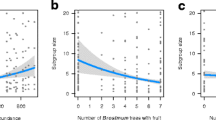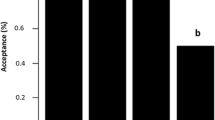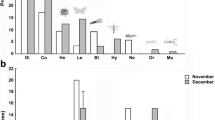Summary
The analysis of ranging patterns of both mono and polyspecific troops of Cercopithecus cephus, C. pogonias, and C. nictitans has shown that association results in a change of habitat use, including a less intensive exploitation and a better selection of the areas with the richest supply of fruit species. Consequently, associated species of Cercopithecus showed a more efficient search for fruit and a more diversified diet. In contrast, no such evidence was found for insect foraging.
A clear interspecific division of roles in the patterns of waring about aerial and terrestrial predators has been demonstrated. The nictitans and pogonias species, living in the higher strata, were informed of terrestrial predators by C. cephus monkeys, which live lower. In turn, the latter benefitted from the C. pogonias male's loud calls given in the presence of aerial danger. Some evidence suggests that predation by the monkey-eagle upon C. cephus was decreased by the association.
Although both foraging efficiency and predator avoidance appeared to be improved by polyspecific association, several facts suggest that predation pressure, notably by the crowned hawk eagle, was the pime factor for the evolution of this life style.
Similar content being viewed by others
References
Crook JH (1970) The socio-ecology of Primates. In: Crook JH (ed) Social behaviour of birds and mammals. Academic Press, London New York, pp 103–159
Freeland WJ (1977) Blood-sucking flies and primate polyspecific associations. Nature 269:801–802
Galat-Luong A, Galat G (1978) Abondance relative et associations plurispecifiques des primates diurnes du parc national de Taï, Côte d'Ivoire. ORSTOM, Projet Taï, 1–39
Gandini G, Baldwin PJ (1978) An encounter between chimpanzees and a leopard in Senegal. Carnivore 1:107–109
Gartlan JS, Struhsaker TT (1972) Polyspecific association and niche separation of rain-forest anthropoids in Cameroon, West Africa. J Zool (Lond) 168:221–266
Gautier JP, Gautier-Hion A (1969) Les associations polyspécifiques chez les Cercopithecidae du Gabon. Terre Vie 116:164–201
Gautier JP, Gautier-Hion A (1977) Communication in old world monkeys. In: Sebeok TE (ed) How animals communicate. Indiana University Press, Bloomington London, pp 890–964
Gautier JP, Gautier-Hion A (1983) Comportement vocal des mâles adultes et organisation supraspécifique dans les troupes polyspécifiques de cercopithèques. Folia Primatol (in press)
Gautier-Hion A (1971) L'écologie du talapoin du Gabon, Miopithecus talapoin. Terre Vie 4:427–490
Gautier-Hion A (1980) Seasonal variations of diet related to species and sex in a community of Cercopithecus monkeys. J Anim Ecol 49:237–269
Gautier-Hion A, Gautier JP (1974) Les associations Polyspécifiques du plateau de M'passa, Gabon. Folia Primatol 22:134–177
Gautier-Hion A, Gautier JP (1976) croissance, maturité sociale et sexuelle, reproduction chez les Cercopithecinés forestiers arboricoles. Folia Primatol 4:103–118
Gautier-Hion A, Gautier JP (1978) Le singe de Brazza: une stratégie originale. Z Tierpsychol 46:84–104
Gautier-Hion A, Gautier JP, Quris R (1981) Forest structure and fruit availability as complementary factors influencing the habitat use by a troop of C. cephus. Rev Ecol (Terre Vie) 35:511–536
Levins R (1968) Evolution in changing enviroments. Princeton University Press, Princeton
Pianka ER (1973) The structure of lizard communities. Annu Rev Ecol Syst 4:53–74
Quris R, Gautier JP, Gautier-Hion A (1981) Organisation spatio-temporelle des activités individuelles et sociales dans une troupe de Cercopithecus cephus. Rev Ecol (Terre Vie) 35:37–53
Rudran R (1978) Socioecology of the blue monkeys (Cercopithecus mitis stuhlmanni) of the Kibale forest, Uganda. Smithson Contrib Zool 249:1–88
Struhsaker TT (1978) Food habits of five monkey species in the Kibale forest, Uganda. In: Chivers DJ, Herbert H (eds) Recent advances in Primatology, vol I, Behaviour. Academic Press, London New York, pp 225–248
Struhsaker TT (1981) Polyspecific associations among tropical rain-forest primates. Z Tierpsychol 57:268–304
Waser P (1980) Polyspecific association of Cercocebus albigena: geographic variation and ecological correlates. Folia Primatol 33:57–76
Waser P (1982) Polyspecific associations: do they occur by chance? Anim Behav 30:1–8
Author information
Authors and Affiliations
Rights and permissions
About this article
Cite this article
Gautier-Hion, A., Quris, R. & Gautier, JP. Monospecific vs polyspecific life: A comparative study of foraging and antipredatory tactics in a community of Cercopithecus monkeys. Behav Ecol Sociobiol 12, 325–335 (1983). https://doi.org/10.1007/BF00302901
Received:
Accepted:
Issue Date:
DOI: https://doi.org/10.1007/BF00302901




